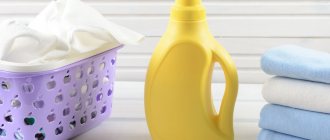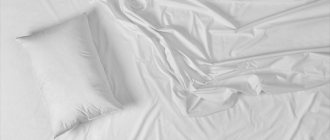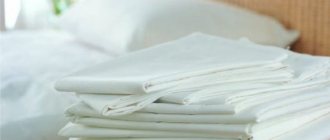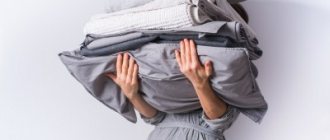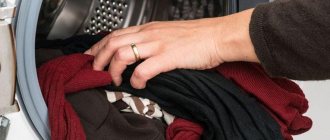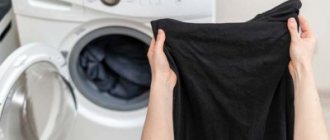How to bleach bed linen without damaging the structure and so that it lasts for many, many years. It’s especially unfortunate for linen items, which themselves have a long service life. Next, we will look at the best and most reliable methods and tricks for whitening laundry. And also a grandmother’s recipe that you may not have heard of.
- Why does laundry turn gray?
- How to bleach laundry in a washing machine
- How to whiten sheets at home
- How to make whiteness at home
- The best way to bleach laundry at home
- Grandma's Secret Way to Whiten Laundry
Why does laundry turn gray?
You love to use white bed linen, but over time the linen becomes yellow or gray. Most often this occurs due to the use of powders, which color the fabric when interacting with water salts, as well as due to the hardness of the water. Especially in cities, water is hard and contains a huge amount of salts.
If your room is damp, then you are guaranteed to get sheets with mold and an unpleasant odor during storage, especially if you do not completely dry the bed linen after washing.
If you threw some colored laundry during washing, you may find unsightly gray or yellow spots on the laundry after washing.
No boiling
If there is no desire or opportunity, then you can turn yellowed items into snow-white ones using regular washing. They do this in the following sequence:
- Soak the products in hot water (60 degrees) for 2-10 hours.
- Before washing, remove the laundry from the water in which it was soaked and twist it.
- Prepare a solution for washing: 5 liters. warm water, take 200 ml of soap solution (dry or liquid stain remover).
- Place bedding in the solution and squeeze thoroughly for 5-10 minutes.
- Rinse the products 2-3 times (until the soap bubbles on the surface of the water disappear), add a few drops of blue to the last rinse.
This is the sequence for hand washing. Using a washing machine makes adjustments to this list: the first three points do not change, but instead of 4 and 5, the laundry wrung out after soaking is placed in the drum and the appropriate mode is selected.
How to bleach bed linen in a washing machine
We wash in the washing machine quite often, but you can improve the washing powder and whiten slightly grayed bed linen.
What is good about bleaching in a washing machine:
- No need to soak separately in a basin and no need to boil
- Save time
- Don't get burned if you decide to boil your sheets
- The automatic machine has enough functions: you can set it for boiling, additional soaking and rinsing.
How to wash white clothes in a washing machine:
- We throw white bedding and sheets into the drum. Try to throw only certain laundry, without mixing with other colored or delicate items. By the way, in the article I wrote how to choose bed linen, where you will find the best option for bed material and understand the service life of each of them.
- Pour washing powder and oxygen bleach into the compartments of the tray. There are separate special trays for them in the machine: for powder with the “II” icon, for bleach with a triangle.
- Select a mode based on fabric type. Always pay attention to what is written on the label before washing clothes. Linen fabrics are washed at maximum temperature, but chintz may not withstand even 60°C due to its thin thread structure.
- Start the car. After washing, hang your laundry out of direct sunlight to preserve as much fiber as possible.
If you do not have a separate tray for bleaching, you can mix the powders together, or add bleach separately after when the mode switches to the second wash.
From my own experience, I can say that I opted for oxygen bleaches, such as Bos, and also recently began to use Vanish.
Our opinion about exotics
Many people recommend bleaching laundry with potassium permanganate. We do not recommend! It is difficult to carefully dilute potassium permanganate; it still settles in the form of small dots at the bottom of the container. If such a “dot” accidentally gets on your sheet, the stain will remain forever.
We recently learned about a method of bleaching eggs with shells. We don’t know, we didn’t have to try it, because... We didn’t collect 100 grams of shells, they were too light. But if someone has a lot of shells on their household, take 100 grams, sew them into a linen bag, and put it in the washing machine, directly into the drum. They say that the product perfectly whitens clothes during washing.
Use the suggested tips and remember that it is much easier not to “wear out” an item than to bleach it afterwards.
How do you like the article?
How to whiten sheets at home
Most often, the sheets in the house still get dirty. And they have to be soaked separately periodically to keep it as white as possible.
In this case, a solution made from 10 tbsp is perfect. soda, 5 tbsp. ammonia or ammonia and 10 liters (galvanized iron bucket) of warm water.
Leave the sheets for 3 hours, but do not forget to stir occasionally. This way you will help the solution get into every fiber of the fabric.
If you feel that the laundry has not bleached, increase the soaking time by another 1-2 hours. Rinse the sheets thoroughly.
For slight yellowing, just add a little baking soda to the powder compartment during normal machine washing.
How to bleach bed linen
How to bleach linen sheets at home
Linen sheets can withstand boiling. You can easily arrange a “bathhouse” for them. To do this, you will need washing powder, BOS oxygen bleach and a little grated laundry soap.
Stir the ingredients until completely dissolved and heat the water in a large enamel bowl. Place the sheet in a bowl and bring to a boil. Leave it soaked in boiling water until the water cools down. Next, wash it again in the washing machine as usual.
Boiling
The procedure for boiling clothes, towels, and bed linen began to be used back in the 14th century in Europe, America and Rus'. The purpose of boiling products was not only hygienic cleaning of dirt, but also disinfection - the destruction of deadly viruses, bacteria, and infections. Today, this function is performed by professional preparations, and boiling is used as a way to eliminate yellowness. Recommendations for digestion:
For the procedure you will need a large container - a bowl, pan, boiling water.- The laundry must be placed in cold water with diluted detergent, and only then heated.
- You need to boil the wash for at least 2 hours, stirring regularly with a wooden object.
- After boiling, do not remove it from the container, but leave it in it until it cools.
To add shine and eliminate yellowness, add methylene blue solution (blue) to the water for rinsing boiled bed linen in the proportions of 5 drops per 10 liters. water.
Important! If you place dirty laundry in boiled water, the yellowness and stains will not disappear, but will penetrate even deeper into the fabric.
How to make whiteness at home
If for some reason you did not have time to buy whitening, or you want to use handy means, then these methods of bleaching bed linen are suitable for you.
Ammonia and hydrogen peroxide
You will need 2 tablespoons of peroxide, 1 tbsp. ammonia and 5 liters of water. Heat to 70°C and soak for 2-3 hours. This method is especially suitable for silk linen and satin.
Aspirin as a bleach
This method of whitening bed linen is simple, but at the same time effective for white linen. Dissolve 5-7 aspirin tablets in 7 liters of warm water. Leave for 8-12 hours. Then throw the laundry into the washing machine and wash on the cycle you choose. To enhance the effect, you can also throw aspirin out of the car, after crushing the tablets.
Laundry soap
In my opinion, the most profitable way to recreate whiteness at home.
Dissolve 2 tablespoons of grated laundry soap and add a couple of tablespoons of salt, soda, hydrogen peroxide or a few crystals of potassium permanganate to enhance the effect.
Here you can vary and add 1-3 additional ingredients. The hostess can choose the appropriate option herself.
Next, soak the laundry for 2-3 hours, rinse and machine wash. This method is perfect for whitening children's bedding.
Vinegar
Vinegar is an excellent bleach, which is ready for use and is in the kitchen of every housewife.
Add 1/2 cup to laundry and machine wash on normal cycle. For heavily soiled sheets, especially the sheets, soak the laundry in warm water with a glass of vinegar overnight. Then rinse and wash the items.
Do not forget that only linen and cotton bedding can be boiled
Ammonia and hydrogen peroxide
Probably one of the most caustic compounds that can be prepared at home. Dilute 30 ml of ammonia and hydrogen peroxide in 5 liters of water. Heat to 70 degrees and soak for half an hour. If you are still wondering how to whiten bed linen, then choose this method.
With this method, the laundry must be thoroughly washed to prevent reaction with powder residues. After soaking, rinse and machine wash in the selected mode.
The best way to bleach laundry at home
It is important to understand here that there are many ways and each housewife adapts to her own method. But increasingly, they began to refuse to use chlorine-containing products, due to its toxicity during hand washing and the rapid deterioration of the fiber of the laundry.
Bleaching with household chemicals
The easiest option is to purchase bed linen bleach, which may be chlorine-based. There are also oxygen and optical brighteners. Methods of use are always described on the packaging of bleaching products.
White remains the cheapest product, but due to the chemical component it is not always suitable for allergy sufferers and people with sensitive skin. Whiteness also has a disinfecting property, which also gives it a certain bonus.
The most delicate of the purchased products are oxygen bleaches, which not only whiten, but also add brightness to colored items. And if you want to refresh your colored bed linen, then this is the best option.
You should also not forget about home methods. And it’s worth trying several options and choosing the most suitable one for yourself.
Do not forget also that there are rules for whitening laundry at home:
- Soak at the strictly recommended dose and time, as the performance properties depend on this.
- Do not remove traces of rust with chemicals. So you can only spread them over the entire surface.
- Try to soak things in a plastic bowl to prevent accidental reaction with the metal.
- Strong bleaching agents, such as bleach, ammonia, are not recommended for every wash. Bleach them as needed.
Special industrial bleaching agents (some recommendations)
The easiest way to whiten yellowed sheets, duvet covers and pillowcases is to buy a stain remover at the store and wash the items in its solution. But, this method requires compliance with the rules:
- Before washing, you need to study the manufacturer's recommendations on the label: temperature, spin, warnings.
- You need to pre-soak your laundry separately from other items, especially colored ones.
- Chlorine-containing products are not suitable for cotton fabrics with embroidery - its aggressive components destroy natural fibers.
To achieve maximum whitening effect, you need to use products marked “for white”, which include: sodium perborate, fumaric acid, subtilisin.
Textile upholstery of a sofa: how to wash off blood?
To clean a sofa whose upholstery is made of textiles, professionals use a cheap and effective method - laundry soap.
Regular laundry soap is quite suitable for removing stains.
Pre-treatment of the fabric occurs with cold water: accessible dirt is wiped off with a dampened rag. The movement is the same as when cleaning a mattress: from the edges to the center.
Wash the stain off the upholstery using a regular soap solution, moving from the edges to the center of the stain
Using a clean, damp sponge, completely wash off the foam and traces of laundry soap.
Pre-cleaning is complete; just use a sponge to continue. The maximum amount of laundry soap is applied to it. The stain is rubbed until foam forms, after which the soap is removed with water and a sponge.
To wash off blood from upholstered furniture, you can use special products after pre-treating the stain with an ice cube.
Removing old blood stains: cleaning method
Dried, stubborn dirt requires a little more effort to remove from fabrics. But the main rule also applies: wash only with cold water. In addition to regular soaking, folk practices are used for cleaning. Ammonia, hydrogen peroxide, lemon juice, glycerin and ordinary laundry soap (72%) will help here.
Ammonia has a peculiar smell, but is quite useful for removing stains
A glycerin solution can also be tried on inconspicuous areas of tissue.
Freshly squeezed lemon juice is an excellent folk remedy for removing stains.
If none of the traditional cleaning methods work, then it is important to resort to the help of a strong stain remover. But be wary of them - they can discolor and deteriorate the fabric of the sheet. Pre-treat stubborn dirt with a dry brush. Friction will remove some of it.
Application of soda
Is it possible to whiten clothes using a washing machine? Baking soda will help, but it can only remove fresh stains. It is enough to add the bulk substance to the powder compartment and start the washing process to ultimately get things shining with whiteness.
We bleach, starch and use blue
When using special bleach, we recommend that you do not skimp on the cleaning agent itself and water. It’s better to put smaller things, otherwise there won’t be a good result. You can avoid soaking and boiling in the following way.
We load the clothes into the machine, add powder, set the temperature to 30 degrees and completely turn off the spin cycle. At the end of the cycle, turn on the standard mode, not forgetting to add more washing powder. You can emphasize the snowy freshness by starching and bluing the fabric. We carry out these procedures during rinsing.
To starch fabric, pour a small amount of starch (from 1/4 teaspoon to 1 tablespoon, depending on the amount of work and the desired degree of hardness) into a glass, add water, stir and pour into the basin where you are going to rinse the item of clothing.
It should be rinsed, taken out of the water and wrapped in a towel. We dry the starched product in a straightened form - placing it on a towel or hanging it on a rope.
For bluing, use a small amount of blue or a couple of drops of brilliant green, which is added to a bowl of water for rinsing. After rinsing, twist and dry the product as usual.
Whitening Precautions
Bleaching bed linen at home requires following recommendations and precautions that will help avoid negative consequences for the skin and respiratory tract, as well as fabric damage.
- Follow all recommendations strictly! Many housewives increase the recommended soaking time or add too much bleach. This reduces the performance characteristics of the fabric.
- Traces of rust should not be removed with chemical bleaches: the contamination can spread over the entire surface of the laundry.
- It is preferable to soak laundry in plastic containers. If you are using an aluminum product, there should be no chips on it, as they may react with bleaching agents.
- Bleach and products containing chlorine should be used only when necessary, and not with every wash. These substances have an aggressive effect on the tissue. Frequent use of these products leads to rapid wear of bed linen.
Important! If a product has a label with a triangle crossed out by two lines, then it cannot be bleached.
Simple measures will help you avoid the need to bleach things: soaking before washing in plain water or adding a couple of drops of lemon, frequently changing bed linen, storing linen in a dry place.
T-shirt designs
This is one of the most non-standard approaches. On boring plain T-shirts, you can create an interesting pattern using bleach. We draw any image on an A4 sheet. Next, lay down a sheet of parchment paper (it usually has a yellowish tint and is translucent, so the design will show through). Turn the parchment paper over to the other side and seal the design with strips of double-sided tape. Cut out the image along the contour so that only the silhouette remains. Removes the protective layer of double-sided tape. We put perforated cardboard inside the T-shirt. We paste the ornament onto the T-shirt, smoothing the picture or pressing it with our hands. When working with a design, it is better to cover the T-shirt with paper or other material so as not to accidentally damage the fabric. Pour 20 grams of bleach and spray it over the surface of the drawing (do not pour it, you need a sprayer). Apply a napkin to absorb excess liquid. Next, you need to dry it well, you can iron the design with an iron, then spray it and dry it again. Watch how the color changes. It is advisable to apply this idea to dark or colored T-shirts.
This is interesting: Is it possible to add powder to the drum of a washing machine, what will happen from this - we explain it step by step
Soak and boil
Washing white linen has its own characteristics. If severe contamination is visible, it is better to pre-soak the products. Take cold, cool or moderately warm water (temperature no more than 40 degrees), and pour a small amount of powder into it. When soaking kitchen towels, we recommend sprinkling in
water table salt. Time for soaking is half an hour, maximum – an hour. Afterwards, the soaked dirt will begin to settle back on the material. After finishing soaking, rub the most noticeable stains with powder or laundry soap and send the items to the wash.
You can easily return the snow-white hue by boiling. However, first make sure that this cleaning method will not harm the structure of the fabric. You can boil bedding made from materials of natural origin, as well as towels.
Boil them immediately after soaking or pre-wash them in the machine. During boiling, you should add a small amount of washing powder (pure or mixed in equal proportions with grated laundry soap).
Fill the pan only one-third full with water so that it does not boil over and soap suds do not run off onto the stove. During the procedure, the contents of the pan must be stirred periodically, and when finished, immediately pull it out of the water.
